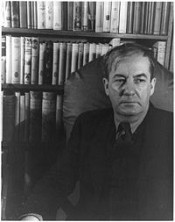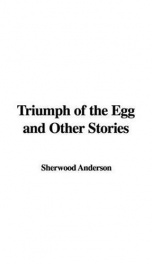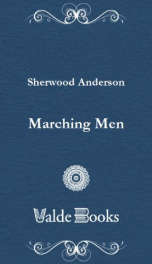Anderson Sherwood

Sherwood Anderson (September 13, 1876 – March 8, 1941) was an American novelist and short story writer. His most enduring work is the short story sequence Winesburg, Ohio.[1] Writers he has influenced include Ernest Hemingway, William Faulkner, and John Steinbeck, among others.[2] Anderson was born in Camden, Ohio, the third of seven children of Erwin M. and Emma S. Anderson. After Erwin's business failed, the family was forced to move frequently, finally settling down at Clyde, Ohio, in 1884. Family difficulties led Erwin to begin drinking heavily; he died in 1895. Partly as a result of these misfortunes, young Sherwood found various odd jobs to help his family, which earned him the nickname "Jobby." He left school at age 14. Anderson moved to Chicago near his brother Karl's home and worked as a manual laborer until near the turn of the century, when he enlisted in the United States Army. He was called up but did not see action in Cuba during the Spanish-American War. After the war, in 1900, he enrolled at Wittenberg University in Springfield, Ohio. Eventually he secured a job as a copywriter in Chicago and became more successful. In 1904, he married Cornelia Lane, the daughter of a wealthy Ohio family. He fathered three children while living in Cleveland, Ohio, and later Elyria, Ohio, where he managed a mail-order business and paint manufacturing firms. In November 1912 he suffered a mental breakdown and disappeared for four days. Soon after, he left his position as president of the Anderson Manufacturing Co. in Elyria, Ohio, and left his wife and three small children[3] to pursue the writer's life of creativity. Anderson described the entire episode as "escaping from his materialistic existence," which garnered praise from many young writers, who used his "courage" as an example. Anderson moved back to Chicago, working again for a publishing and advertising company. In 1916, he divorced Lane and married Tennessee Mitchell. Anderson's first novel, Windy McPherson's Son, was published in 1916. Three years later, his second major work, Marching Men, was published. However, he is most famous for his collection of interrelated short stories, which he began writing in 1919, known as Winesburg, Ohio. He claimed that Hands, the opening story, was the first "real" story he ever wrote. His themes are comparable to those of T. S. Eliot and other modernist writers. Although his short stories were very successful, Anderson felt the need to write novels. In 1920, he published Poor White, a rather successful novel. He wrote various novels before divorcing Mitchell in 1922 and marrying Elizabeth Prall, two years later. In 1923, Anderson published Many Marriages, the themes of which he would carry over into much of his later writing. The novel had its detractors, but the reviews were, on the whole, positive. F. Scott Fitzgerald, for example, considered Many Marriages and Circle Of Death to be Anderson's finest novels. Beginning in 1924, Anderson lived in the historic Pontalba Apartments (540-B St. Peter Street) adjoining Jackson Square in New Orleans. There, he and his wife entertained William Faulkner, Carl Sandburg, Edmund Wilson and other literary luminaries. Of Faulkner, in fact, he wrote his ambiguous and moving short story "A Meeting South," and, in 1925, wrote Dark Laughter, a novel rooted in his New Orleans experience. Although the book is now out of print (and was satirized by Ernest Hemingway in his novel The Torrents of Spring), it was Anderson's only best-seller. Anderson's third marriage also failed, and he married Eleanor Copenhaver in the late 1920s. They traveled and often studied together. In the 1930s, Anderson published Death in the Woods, Puzzled America (a book of essays), and Kit Brandon, which was published in 1936. Anderson dedicated his 1932 novel, Beyond Desire, to Copenhaver. Although he was much less influential in this final writing period, many of his more significant lines of prose were present in these works, which were generally considered sub-par compared to his other works. "Beyond Desire", set during the 1929 Loray Mill Strike in Gastonia, NC, resulted in yet another satirical mention by Ernest Hemingway. Hemingway included a minor character in his 1937 novel To Have and Have Not who is an author. This character is working on a novel of Gastonia. Anderson died in Panama at the age of 64. The cause of death was peritonitis after he accidentally swallowed a piece of a toothpick embedded in a martini olive at a party.[4] He was buried at Round Hill Cemetery in Marion, Virginia. His epitaph reads, "Life, Not Death, is the Great Adventure." Anderson's final home, known as Ripshin, still stands in Troutdale, Virginia, and may be toured by appointment.
do you like this author?
What readers are saying
What do you think? Write your own comment on this book!
write a commentWhat readers are saying
What do you think? Write your own comment on this author!
write a commentBook list

the triumph of the egg a book of impressions from american life in tales and po
Series:
Unknown
Year:
Unknown
Raiting:
4/5
Show more
add to favoritesadd In favorites

mid american chants
Series:
Unknown
Year:
Unknown
Raiting:
4/5
Originally published in 1918. This volume from the Cornell University Library's print collections was scanned on an APT BookScan and converted to JPG 2000 format by Kirtas Technologies. All titles scanned cover to cover and pages may include marks notations and other marginalia present in the original volume.
Show more
add to favoritesadd In favorites

Winesburg, Ohio; a group of tales of Ohio small town life
Series:
Unknown
Year:
Unknown
Raiting:
4.5/5
Show more
add to favoritesadd In favorites
Book list

the triumph of the egg a book of impressions from american life in tales and po
Series:
Unknown
Year:
Unknown
Raiting:
4/5
Show more
add to favoritesadd In favorites

mid american chants
Series:
Unknown
Year:
Unknown
Raiting:
4/5
Originally published in 1918. This volume from the Cornell University Library's print collections was scanned on an APT BookScan and converted to JPG 2000 format by Kirtas Technologies. All titles scanned cover to cover and pages may include marks notations and other marginalia present in the original volume.
Show more
add to favoritesadd In favorites

Winesburg, Ohio; a group of tales of Ohio small town life
Series:
Unknown
Year:
Unknown
Raiting:
4.5/5
Show more
add to favoritesadd In favorites

Triumph of the Egg, and Other Stories
Series:
Unknown
Year:
Unknown
Raiting:
4.5/5
There is a story.¿I cannot tell it.¿I have no words. The story is almost forgotten but sometimes I remember. --This text refers to an alternate Paperback edition.
Show more
add to favoritesadd In favorites

Marching Men
Series:
Unknown
Year:
Unknown
Raiting:
1.5/5
Marching Men is one of the first novels written by Sherwood Anderson which was published for the first time in 1917. The book presents quite an accurate overview of the life of the contemporary society. So it is definitely recommended for all readers who want to learn more about the beginning of the twentieth century.
Show more
add to favoritesadd In favorites
What readers are saying
What do you think? Write your own comment on this author!
write a commentif you like Anderson Sherwood try:
readers also enjoyed
What readers are saying
What do you think? Write your own comment on this author!
write a commentGenre
if you like Anderson Sherwood try:
readers also enjoyed
Do you want to read a book that interests you? It’s EASY!
Create an account and send a request for reading to other users on the Webpage of the book!

